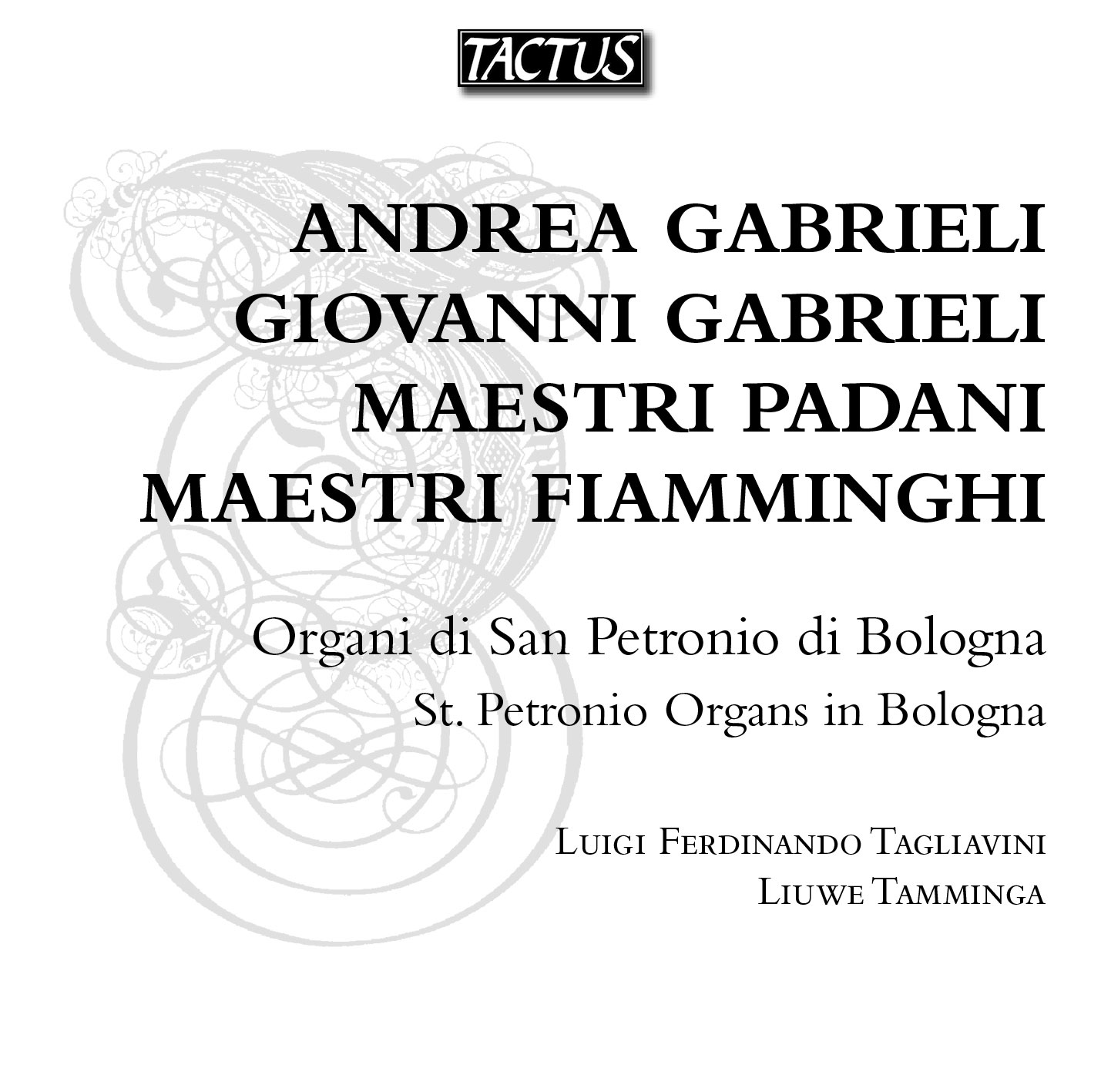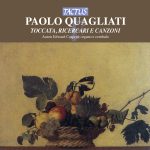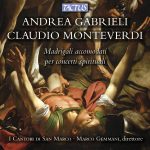Andrea Gabrieli (1510-1586) – Giovanni Gabrieli (1557-1612), Aurelio Bonelli, Claudio Veggio, Jacopo Fogliano, Giulio Segni, Lucio Barbieri, Giovanni de Macque, Adriano Banchieri, Pietro Francese, Marco Antonio Cavazzoni, Girolamo Cavazzoni, Domenico Maria Ferrabosco, Girolamo Frescobaldi, Ercole Pasquini, Tarquinio Merula
CD1: In the list of “celebrated organs\” which appeared in the theoretical work \”Conclusioni nel suono dell”Organo\” (1609) the Bolognese musician Adriano Banchieri included the pair of instruments which at that time graced two important basilicas: the organs “of utmost sweetness” at St. Mark”s in Venice, and the “rare” organs at S. Petronio in his native city Only these latter instruments have survived splendidly restored in 1982 to that original “rarity” referred to by Banchieri and maintaining the characteristic sonorities essential to the repertoire for which they were conceived.
The affinity between these two pairs of instruments, both in terms of their sound and their analogous spatial disposition (in both cases the organs were placed in opposite galleries framed by the dividing arches between the central and side naves), extends to the musical repertoire which flourished at the two institutions.
The provosts of the vestry board (Fabbriceri) of S.
Petronio in 1596 commissioned the organ builder Baldassarre Malamini of Cento (in the province of Ferrara) to provide the basilica with a second instrument that would accompany the organ built between 1471 and 75 by Lorenzo da Prato.
The two instruments show a remarkable resemblance in their sound spectrum.
The contrabbasso Principal of the older organ is rich and full-bodied, with a double rank treble, and corresponds to the “16-foot” Principal of the 16th-century organ, equipped with analogous doubling Similarly, the Principal of the first organ and the Ottava of the second are tripled in the treble.
Finally, the usual pair of Flauti in VIII and in XII of both instruments, of extraordinary lightness and brilliance, complete the sonorous resources of the \”concerto stops”.
A particular attribute of Lorenzo”s gothic organ is the above-mentioned Contrabbasso Principal, a stop which gives to this instrument an absolutely exceptional character: it is, in fact, both the oldest “20 feet” organ known to us, and the largest instrument to have independent stops.
Gabrieli was quite a versatile and prolific composer, and he found himself in Venice the recipient of important musical commissions, despite his unimpressive social and economic standing as organist an occupation comparable to simple artisans.
He was thus given the opportunity to try his hand at ceremonial music such as that for multiple choirs and these pieces comprise the greater part of his collection of Concerti prepared for publication in 1587 by his nephew Giovanni, and including works by both composers.
To this collection belongs the double-choir motet Egredimini et videte, in which the two choirs alternate phrases of various lengths ln such a way as to blend final cadences with initial chords in a single homogeneous flow.
The performance, here entrusted to the two organs, encapsulates the complex contrapuntal interweaving of the eight voices in a keyboard tablature.CD2: The golden carvings which decorate the case of Lorenzo da Prato’s 15th-century organ in S. Petronio, the work of a French artisan, seem almost to illustrate visually the important role played at that time by the musical culture from “beyond the alps’ in the Bolognese basilica.
The characteristic timbre of this impressive instrument is well suited to the northern organ literature of the period, and indeed beginning in 1475, the first three organists to have filled the vaults of the gothic edifice with its music were of Burgundian, Navarrese and French origins, respectively.
The repertoire represented here might serve almost as “provisions” for our journey through a century of trade and mutual influence which occurred between Italian and “ultramontane” organ music.
It ranges from the golden age of the first great Italian organ school, the most significant beginnings of which took place on Emilian soil, to the years immediately following the construction of the second organ in S. Petronio.
The late gothic organ of Lorenzo is exceptionally appropriate to 16th-century music, thanks in part to the contribution made by the organ builders Giovanni Battista Facchetti (1531) and Giovanni Cipri (1563).
This instrument provides a sampling of virtually all the principal timbres offered by the contemporary school of organ building, of which it is today an unparalleled example, both for its size and its age; it is, in fact, both the oldest “20 feet” organ known to us, and the largest instrument to have independent registers.
The sonority of its Principal stops is rich and full-bodied, with doublings of the treble pipes of the Principale Contrabbasso (24’) and Ottava (6’) Principals, and triplings of the 12’ Principal.
During the restoration of 1982, the historical mean-tone temperament was reestablished, and the organ is rare in its being equipped with extra keys at different pitches for G# and A, notes which in modern equal temperament would coincide.
In addition, the exceptional range of the keyboard-4 octaves and a 3rd allows for playing both in 8’ and 16’ tessituras.
Tracklist
CD1:
Giovanni Gabrieli
1. Canzon Primo Tono a 8 a due organi 5:01,
Andrea Gabrieli
2. Intonazione del Primo Tono 1:14,
3. Ricercare del Primo Tono 6:45,
4. Intonazione del Sesto Tono 1:21,
5. Ricercar arioso 3:08,
6. Mottetto Egredimini & videte a 8 a due organi 4:16,
Giovanni Gabrieli
7. Fuga del Nono Tono 2:56,
8. Toccata del Secondo Tono 2:33,
9. Canzon La Spiritata a 4 4:06,
10. Canzon Sol Sol La Sol Fa Mi a 8 a due organi 2:22
Andrea Gabrieli
11. Toccata del Quinto Tono 1:42,
12. Canzon ariosa 3:11,
13. Fantasia allegra 3:15,
14. Io mi son giovinetta a 4, intavolato 3:56,
15. Canzon francese detta Petit Jacquet a 4 2:13,
Giovanni Gabrieli
16. Lieto godea a 8, a due organi 3:22,
17. Toccata del Primo Tono 3:14,
18. Ricercar del Primo Tono 2:22,
19. Canzon del Secondo Tono 3:05,
20. Canzon del Duodecimo Tono 2:51,
21. Canzon XII. T. a 10 a due organi 4:34
CD2:
Aurelio Bonelli
1. Toccata Cleopatra a 8 a due organi 2:53,
Claudio Veggio
2. Ricercata per b quadro del I Tono 5:43,
Jacopo Fogliano
3. Ricercata 1:47
4. Ricercata 2:05,
Giulio Segni
5. Ricercare VI 3:44
6. Ricercare XI 2:19,
Lucio Barbieri
7. Mottetto Laudans exultet a 8 a due organi 4:11,
Giovanni de Macque
8. Capriccio sopra Re Fa Mi Sol 5:36,
9. Consonanze Stravaganti 3:01,
Adriano Banchieri
10. Canzon Francese la Carissima a 8 a due organi 2:40,
Pietro Francese
11. Intonazione del Sesto Tono 1:09
Marco Antonio Cavazzoni
12. Plus ne regres 3:58
Girolamo Cavazzoni
13. Ricercar terzo 6:31,
Domenico Maria Ferrabosco
14. Io mi son giovinetta, intavolato 2:29,
Girolamo Frescobaldi
15. Canzona a 8 a due organi 3:01
Ercole Pasquini
16. Toccata 2:10,
17. Durezze 4:00
18. Canzona 3:29,
Tarquinio Merula
19. Toccata & Genus Cromaticum del I Tono 5:14,
20. Canzona 1:52,
Aurelio Bonelli
21. Toccata Athalanta a 8 a due organi 4:04
- Composer: Andrea Gabrieli (1510-1586) – Giovanni Gabrieli (1557-1612), Aurelio Bonelli, Claudio Veggio, Jacopo Fogliano, Giulio Segni, Lucio Barbieri, Giovanni de Macque, Adriano Banchieri, Pietro Francese, Marco Antonio Cavazzoni, Girolamo Cavazzoni, Domenico Maria Ferrabosco, Girolamo Frescobaldi, Ercole Pasquini, Tarquinio Merula
- Performers: Luigi Ferdinando Tagliavini, Liuwe Tamminga
- Historical Period: Humanism and Renaissance
- Code: TB 460090
- Edition: JUNE 2012
- Barcode: 8007194200195
- Set: 1
- Total tracks: 42
- Total duration: 02:22:20
- Notes: NEW TACTUS WHITE SERIES EDITION







